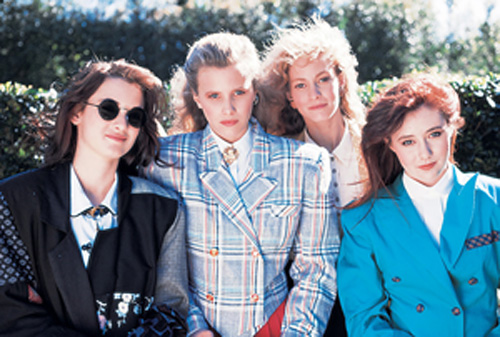“You’re here because you know something. What you know you can’t explain, but you feel it. You felt it your entire life.” – Morpheus, The Matrix
Though Lana Wachowski’s coming out should not be an excuse to limit interpretation of the Wachowski siblings’ most iconic film, The Matrix, to a closeted discussion of gender dysphoria, yet it is a film that is profoundly concerned with psychic dysphoria as sci-fi dystopia: with jarring disconnects between perceived reality and actuality, embodied in a heroic struggle for the reimagination of the self against escalating systems of social control. Ed Wood Jr.’s cult 1953 B-movie, Glen or Glenda, explicitly harnesses classic science fiction to dramatize the psychology of gender dysphoria. As was fictionalized in Tim Burton’s biopic Ed Wood, Wood was a self-accepting crossdresser who approached the topic of gender dysphoria with an empathy almost unique for his era, clumsily advancing enlightened opinions that would later become orthodoxy. There may be deceptive cunning underneath Wood’s film’s rough surface. Assigned to create a cheap, B-movie freak-show exploitation of the notoriety of Christine Jorgensen’s sex change, Wood delivers a freak-show of random mad scientists, mischievously accuses the cismale audience of suffering from pattern baldness due to their failure to wear women’s hats, creates a surreal nightmare of social conditioning, and then allows his transgender subjects to be islands of humanity within this freakish world. He effectively delivers a transgender freakshow in which the transgender are never freaks. On the surface, Wood’s film and the Wachowskis’ could not be more different: one is the cheap and amateurish product of a man popularized by the Golden Turkey Awards as “the worst director of all time,” while the other is a slick blockbuster considered a milestone in special effects, that has spawned serious, academic debate over its philosophical meanings. However, comparing Wood’s deeply personal product with the Wachowskis’ deeply polished one, Glen or Glenda‘s explicit gender dysphoria with The Matrix‘s allegorical dysphoria reveals parallels that illuminate both films.
Dystopia, Now: Contemporary Reality As Sci-Fi Nightmare
“It is the world that has been pulled over your eyes to blind you from the truth” – Morpheus, The Matrix
The most fundamental parallel between The Matrix and Glen or Glenda is their shared concept of present reality as a creation of sci-fi dystopia. In Glen or Glenda, Boris Karloff’s mad scientist is positioned as a creator-figure, who performs sex change transformations with a wave of his hand, while omnisciently supervising all life. Though Karloff’s never-really-specified relationship to the film’s realist narrative, complete with weirdly hovering intrusions over the action, are celebrated ironically as symptoms of Wood’s incompetence and oddness, yet Karloff’s role in Glen or Glenda mirrors that of the machines in The Matrix: he enables a dual discourse of irresistible predestination and faulty creation. Karloff’s “pulling of the string” drives surges of wildebeest like irresistible animal impulses, which place Wood’s hero as a puppet who must “dance to that which one is created for” while recognizing that “nature makes mistakes, it’s proven every day”, just as Neo struggles to accept that he is not in control of his own life through the guidance of his re-creator Morpheus.
Using a nightmare sequence of mobbing crowds and mocking variants of the schoolyard chant “slugs and snails and puppy dog’s tails, that’s what little boys are made of, sugar and spice and all things nice, that’s what little girls are made of,” Wood dramatizes the sinister power of social conditioning in a way that would be considered Lynchian surrealism, if he wasn’t dismissed as the worst director of all time. Where Wood uses a nightmarish dream sequence, the Wachowskis use body horror, in the violation of flesh-penetrating bugs and the imposed silence of a mouth literally sealed shut, to expressively dramatize the sinister power of their Agent “gatekeepers” over the hero’s most intimate body and self. Wood’s visual vocabulary for expressing the internal experience of gender dysphoria is drawn from James Whale’s Frankenstein, a queer lexicon of absent nurture and flawed divinity. The Wachowskis’ visual vocabulary in The Matrix is drawn from Ghost In The Shell, a cyberpunk anime that explores gender identity through a dystopia where characters can explore their identity by “plugging themselves in” to superpowered new bodies (or “shells”) of any gender. The effect of both texts, however, is to code lived reality as a profoundly unnatural and imposed nightmare that is essentially dystopian and demands the psyche’s resistance, symbolized for the Wachowskis by re-Creator Morpheus’ red pill.
Wood’s decision to open his film with a trans* woman’s suicide, narrated through her suicide note of repeated arrests for cross-dressing–“let my body rest in death, forever, in the things I cannot wear in life”–underlines the seriousness of the psychological crisis of gender dysphoria. Wood’s dramatization also recognizes the individual nature of each trans* experience, from the “transvestite,” who was conditioned by the environment of early youth to value femininity over masculinity and yearn to express his feminine side, to the “pseudo-hermaphrodite” Anne, who seems to correspond to a trans woman in her description as “a woman within… indeed meant to be a woman.” Anne challenges gender stereotypes by excelling as an army officer, before choosing a sex change operation. The “removal of the man and the formation of the woman” is represented onscreen by Bela Lugosi’s scientist blessing the new incarnation in a pseudo-religious ceremony.
The Holy Trinity: Variations And Incarnations
“You’ve been living two lives. In one life, you’re Thomas A. Anderson… the other life is lived in computers, where you go by the hacker alias “Neo”… One of these lives has a future and one of them does not.” – Agent Smith, The Matrix
When Keanu Reeves’ hero, hacker Thomas Anderson, is introduced, he has constructed an imaginary identity and vicarious second life as “Neo” that is confined within the cyber-realm. The basic plot of the first film is Anderson’s gradual embrace and embodiment of “Neo” as his true identity, while realizing his imposed identity of Thomas Anderson as a fictional construct. It is Hugo Weaving’s sinister Agent Smith of the social-conditioning “matrix” who continually imposes the (explicitly masculine) identity of “Mr. Anderson” onto Neo. It is when Neo finally resists and asserts “my name is Neo!” that he frees himself from the inevitability of his defeat. It is Neo’s allies who affirm his true identity, with Trinity’s iron belief in his potential self, embodied as a kiss, acting as the catalyst for his final awakening into unbounded liberation. Many commentators have pointed out that Neo can be read as a Christ allegory. Fewer have highlighted that Trinity’s name evokes the Holy Trinity’s conception of a single being’s incarnation into multiple forms. If Morpheus functions as a Creator/Father mentor to Neo’s Christ-figure, Trinity must represent his Holy Spirit. Her kiss is therefore not only Mary Magdalene’s handmaiden witnessing Christ’s resurrection, but the descent of the dove/spirit as agent of his baptism and awakening to mission.
The film’s iconic uniform of black leather, slicked back hair and shades visually codes Carrie-Anne Moss as a female variant of Keanu Reeves’ hero, reimagining the patriarchal Holy Trinity of the Christian religion as a transracial, transsexual one (the theme of transracial incarnation would later play a controversially race-bending role in the Wachowskis’ Cloud Atlas). While the dizzying complexity of the Matrix sequels are beyond the scope of my study, it should be noted that they center on Neo’s battle through ever complicating systems of social control and predestination to avoid the compelled sacrifice of Trinity. A traditional feminist reading would bemoan that Trinity serves as yet another apparently Strong Woman reduced to damsel-in-distress. However, reading Trinity as Neo’s liberated alter-ego enables an interpretation that is more coherent and thematically rich. Trinity is introduced before Neo – demonstrating her super-strength and desirable mastery over laws of nature, she is his ultimate goal throughout the films.
Glen Or Glenda describes the relationship of “Glen” and “Glenda” as “not half man, half woman, but nevertheless man and woman in the same body,” evokes the idea of multiple incarnation of a unified being. A kind of trinity is established between Glen, Glenda and the supervising creator Karloff, similar to that between Morpheus, Trinity and Neo.
The Blue Pill: The Lure Of The Cure
“You take the blue pill, the story ends, you wake up in your bed and believe whatever you want to believe.” – Morpheus, The Matrix
In The Matrix, the “blue pill” represents returning to the “prison for your mind” that is coercive social conditioning. The character of Cypher represents the lure of the cure, in rejecting the “desert of the real” with its lack of comforts, its isolation and its persecution by patrolling machines, in order to resume a pre-programmed, conforming life where he forgets his past and betrays the team because “ignorance is bliss.”
Neo is dissuaded from his own instincts for comforting conformity by Trinity, the empowered alter-ego who gives him strength to resist his moments of doubt with her own certainty: “You know that road. You know exactly where it ends. And I know that’s not where you wanna be.” In Glen or Glenda, Barbara becomes the strengthening image, with her willingness to accept and love Glen, even if he never abandons women’s clothing, being the catalyst for his mental freedom. While insisting that a sex change is a happy ending for Anne, Glen’s happy ending becomes his reabsorption into a standard male role by finding his cravings for loving femininity fully answered by Barbara. This ending satisfies the mainstream audience’s urge to “cure” Glen, but only if they can grant the trans* audience’s demand that Glenda be accepted as she is, as a part of Glen, as a crucial precondition of the cure.
Gender policing limits the opportunities for full self-realization of all people, though their realized selves might take many forms across a wide spectrum of gender identity. In Lugosi’s words, “one is wrong because he does right. One is right because he does wrong.” Paradoxically, the mainstream audience are the obstacle to their own liberation, because of their mental indoctrination into an ideology of gender policing. As The Matrix‘s Morpheus puts it, they are “the very minds of the people we are trying to save, but until we do these people are still a part of that system, and that makes them our enemy.” Or as Glen or Glenda has it: “You Are Society – JUDGE YE NOT.” In the struggle to envision a world without rules or controls, without borders or boundaries, the self-actualization of all people is implied. As long as their matrix of policing thoughts and ingrained prejudices exists, the human race will never be free. What an everyday nightmare.
[youtube_sc url=”https://www.youtube.com/watch?v=2vUoSPJm5w0″]
Brigit McCone covets the Bride of Frankenstein hairdo, writes and directs short films and radio dramas. Her hobbies include doodling and hanging out with her friends.









